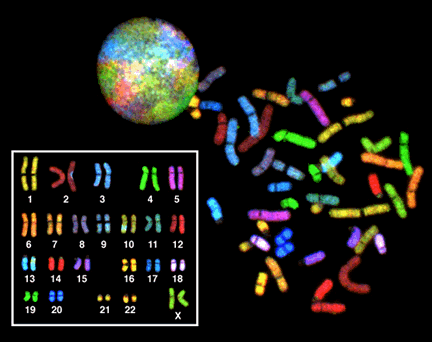Chromosomal Features
![By NIH, User:Phrood, En rouge [Public domain or Public domain], via Wikimedia Commons](https://openlab.citytech.cuny.edu/bio1-oer/files/2015/06/chromosomes-953x1024.png)
Chromosomes in Interphase are not visible individually. In preparation for nuclear division (mitosis or meiosis), they begin to organize tighter and condense in preparation for movement to subsequent daughter nuclei. The animation below illustrates the process of histone packaging and the molecular visualization of DNA replication. Histones are proteins that aid in packaging of the chromosomes into organized coils that give rise to the recognizable chromosomes during metaphase.
Large-scale genomic rearrangements result in genetic abnormalities. Biologists utilize a technique called a chromosome spread followed by a karyotype or karyogram. To make a chromosome spread, one blocks the progression of mitosis at metaphase where chromosomes are condensed into the structures we are familiar. A karyotype analysis is an arrangement of the chromosome spread into the homologous pairs of chromosomes.

Events associated with the improper separation of chromosomes during metaphase results in an alteration of chromosome number in the subsequent generation of cells. Using the Pop-beads, we can understand better how the timing of these events will lead to differences in the karyotype.
Tags: applied knowledge, life-long learning


